When a dog pees on their owner’s bed, the first human reaction is often confusion followed by denial. “What is this big, wet spot on my bed? It can’t be dog pee. It just can’t be!”
Anger comes next. But before you do something you’ll regret, it’s important to take a step back and ask yourself one important question: “Why did my dog pee on my bed?”
The answer may surprise you. But it’ll also improve your understanding of dog behavior, and maybe even help your furry friend.
With that in mind, here are the major reasons why dogs pee on their owners’ beds, and the best solutions for each.
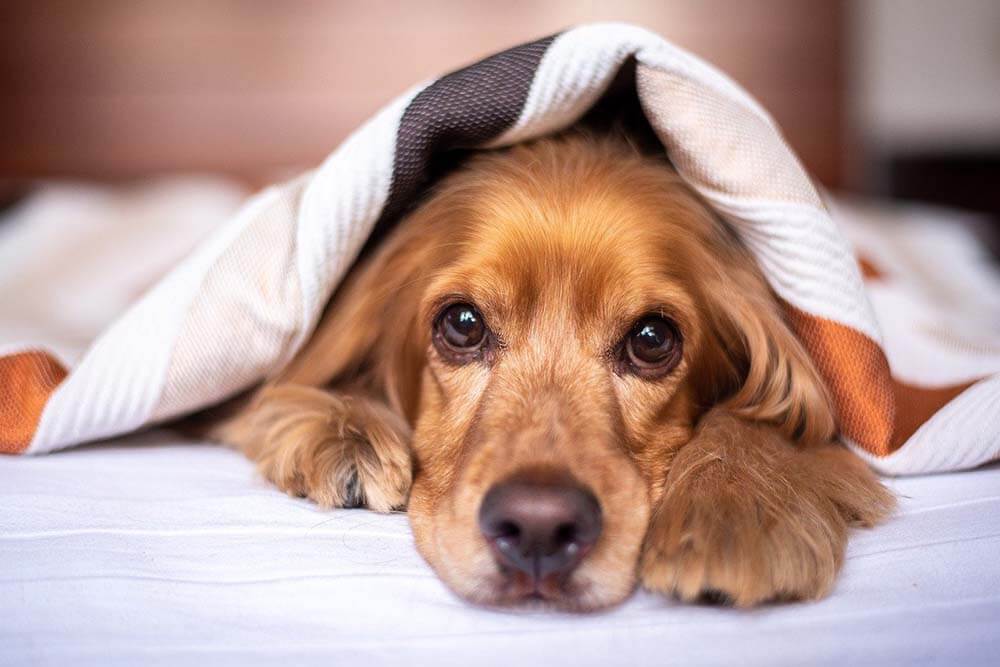
1. Health issues
Untreated medical issues may be behind your dog’s unwanted or destructive behavior.
A urinary tract infection, which is more common among female dogs, can result in discomfort and frequent urination. Other urinary problems that can cause inappropriate urination include kidney disease, bladder stones, bladder inflammation, and tumors.
Dogs that pee frequently, dribble urine, lick their privates excessively, experience pain during urination, or pass bloody urine may be showing signs of health issues. Extremely well-behaved dogs that suddenly urinate where they shouldn’t may also be enduring one or more problems.
Is your dog peeing while they’re asleep or dribbling urine while they’re awake? They may be suffering from incontinence. This issue is more common in older dogs. A form of incontinence known as hormone-responsive urinary incontinence affects female dogs, especially those that have been spayed.
A serious medical condition such as diabetes or Cushing’s disease can also encourage inappropriate peeing.
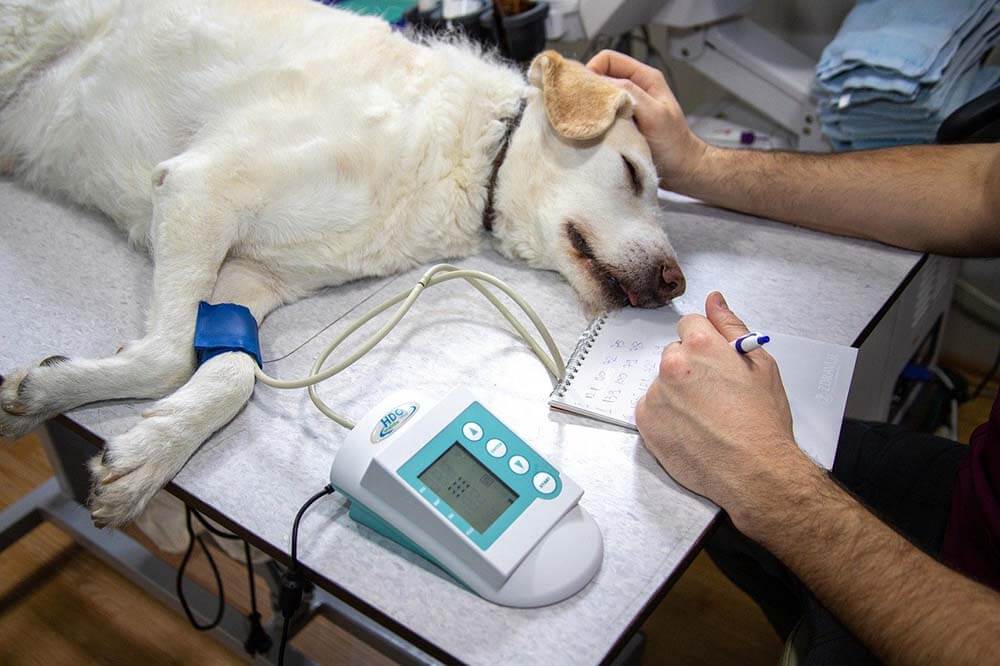
What to do:
As there could be a medical explanation for your pet’s troubling conduct, you should consult a veterinarian the moment your dog pees on the bed or displays any of the other aforementioned symptoms.
To determine if your pooch is suffering from a medical issue, the veterinarian will subject them to a combination of medical examinations that may include a urinalysis and a blood test. Using the results as a basis, they’ll then develop a treatment plan, which you should strictly observe to ensure your furry friend’s health.
Once your veterinarian has ruled out medical reasons for why your dog pees on your bed, you can start addressing their undesirable behaviors.
2. Lack of training
As an untrained dog is less likely to curb their instincts, they may go potty wherever it’s convenient for them. They may even end up favoring specific spots over others. Too bad for you if that spot is your bed!
Your dog peeing on the bed may also be a sign of their love for you. Their powerful sense of smell draws them to your scent, which brings them to your bed. They then pee on the bed to disguise your scent from “predators.”
If a dog is to be a household pet, you’ll need to house train them. A puppy barely has any control over their bodily functions, but they can learn surprisingly quickly. And, contrary to the common saying, it is possible to teach an old dog new tricks, so it’s never too late to potty train a physically mature dog. If you’re the proud owner of a rescue dog whose history you know nothing about, make an effort to train them, because it’s possible their last owner didn’t.
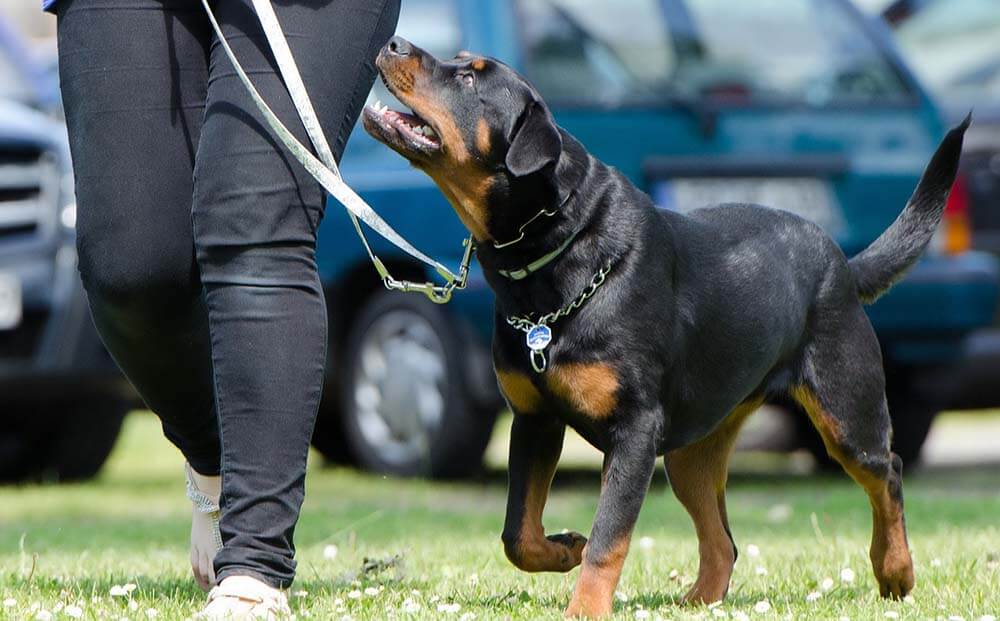
What to do:
Consistent, regular potty training will help your dog understand that peeing on your bed is a no-no.
Around half an hour after your dog eats or drinks, take them outside so they learn to avoid doing their business inside the house. When they’re done peeing, immediately reward them with treats and praises so they understand you approve of their behavior.
Whether or not they’ve just eaten or drunk, take your dog outside the house every three to four hours to give them opportunities to relieve themselves. Reward your dog and let them back inside once they’ve finished. Be consistent with your schedule so as not to confuse your dog.
Be observant of their behaviors. If they’re sniffing the ground obsessively, there’s a good chance they’re searching for a spot to urinate on, so immediately scoop them up and bring them outside.
Restrict your dog’s access to the bedroom and other places you don’t want them to pee in. You can have your dog stay in a crate for short periods (learn more about the positives of crate training further below). Once your dog learns to pee only in designated areas, you can grant them more freedom of movement inside your home.
Puppies are more challenging to train as they’re less able to grasp your intentions. They also can’t hold in their pee for too long. With patience and consistency, however, they’ll learn to tell bad behavior from the good. Don’t punish them if they do end up having an “accident,” but don’t reward them either. As they mature, they’ll grow better at controlling their bladder and obeying your rules.
3. Anxiety, fear, or excitement
Dogs with a tendency towards anxiety or fear are often overly submissive – a trait that makes them more obedient and easier to train. However, what at first seems like a good thing may become one of every dog owner’s worst nightmares: a dog that won’t stop peeing on the bed, the bedroom door, the carpet, and everywhere else. This is because extremely submissive pooches are more likely to urinate frequently where they’re not supposed to. To these “submissive eliminators,” squatting or tinkling whenever you enter the room is their way of telling you they respect you.
A dog whose previous owner was abusive may also grow extra nervous and thus more prone to inappropriate urination. Keep this in mind when you bring home a scared rescue dog.
When you leave the house, your dog may fear you’re never coming back, leading to separation anxiety or a panic attack. A loud noise, such as a firework explosion, can also frighten dogs into peeing on your bed. Additionally, changes in the environment and even your own stress can cause canine anxiety.
Another cause of inappropriate urination is excitement. A dog that’s happy to see you, for example, may end up assuming a submissive position and/or dribbling urine all over the floor. Thankfully, this is more common in puppies, who eventually outgrow the behavior. House training can help those that don’t.
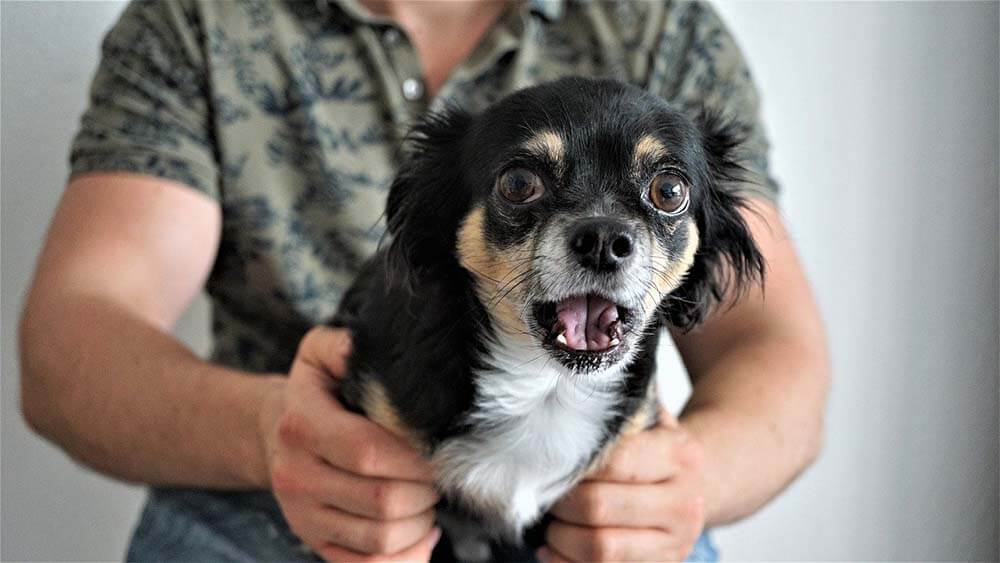
What to do:
Because training develops the human-canine bond, it cultivates your dog’s trust in you as well as their feelings of safety and security. A well-trained dog is therefore a less anxious dog.
Make sure your dog receives regular, proper training that doesn’t stop with potty training. Teach your dog to obey you and perform tricks. You can even ask a seasoned dog trainer to give them more advanced lessons; just remember to have practice sessions with your dog yourself.
Stick with tried-and-tested training techniques such as positive reinforcement and clicker training. Avoid harsh punishments such as screaming at or hitting your dog, as these can make them even more prone to fear and anxiety.
Another way to boost your dog’s sense of security is to crate train them. With time and proper technique, your dog will learn to see their crate or ex pens as the shelter within which they can find safety and relaxation whenever they’re unsettled or tired.
Your vet can also prescribe supplements and medications that can alleviate your dog’s anxiety.
Lastly, show your dog lots of affection. Heap them with praises and give them treats whenever they engage in positive behavior. Play games with them and take them for daily walks to stimulate their mind and body. The more loved and entertained your furbaby feels, the less likely they’ll soil your bed with dog pee.
4. Territorial marking
Also known as scent marking, the marking of territory by urinating on something is a behavior most dogs engage in. The more territorial the dog is, the greater the possibility they’ll take a leak on the bed. After all, they have to show you who’s boss!
Dogs mark their territory to claim ownership over an area and advertise that ownership to other animals, and as such is not done by accident. If they urinate on a bush, they’re saying, “This spot is mine, not yours; go find your own spot!” Peeing on your bed therefore means, “This area of the bed is mine, human, and don’t you forget it!”
While female dogs do assert dominance this way, the behavior is more common in male dogs. Unspayed or unneutered dogs are also more likely to mark territory.
Another reason behind scent marking is anxiety. Many stressed-out or fearful dogs are constantly worrying about their favorite spots and possessions being stolen from them, which explains their constant need to remind other creatures of their territory.
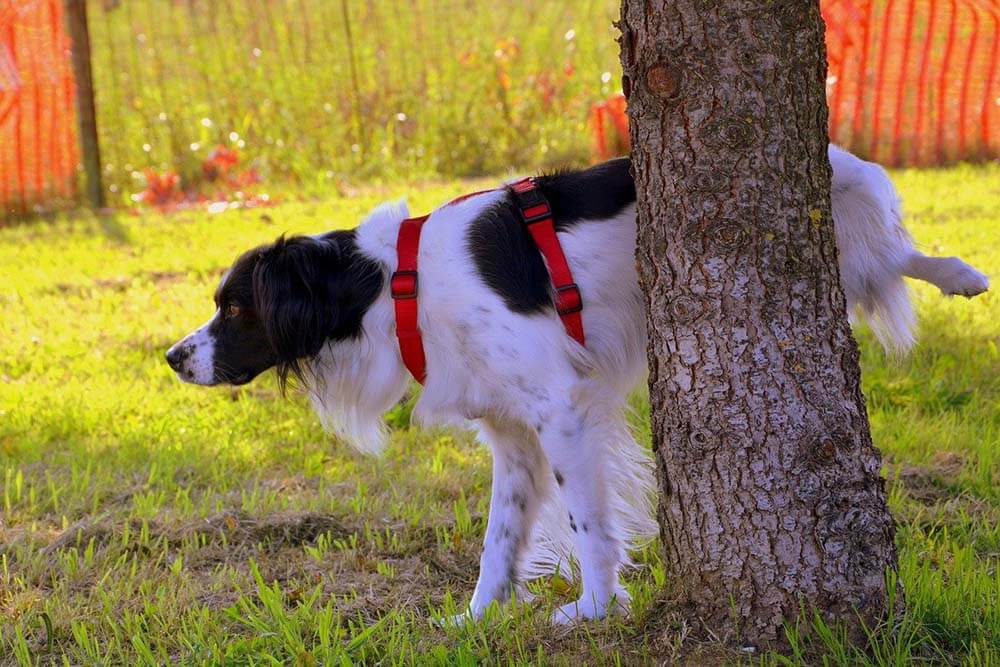
What to do:
Marking territory through inappropriate whizzing can be curtailed through strict training. Teach your dog to obey you instead of the other way round. If, for example, Fido barks to let you know they want you to come to them, avoid giving in to their demands. Provide them with treats and praises only when they do something desirable, such as following your commands.
You may need the help of a professional dog trainer to train an extremely territorial dog.
Having a male dog neutered can also drastically reduce or eliminate this behavior.
Crate training
As stated by the American Kennel Club, crate training is an excellent potty training tool.
The first couple of times you place your dog inside their crate, leave the door open and stay beside the crate to let them know they’re safe. Praise them whenever they enter the crate, then feed them treats and meals while they’re inside so they associate crating with good things.
A puppy or dog that’s new to crating will complain about their confinement; try not to feel like you’re being an awful fur parent and don’t let them out until they calm down. Over time, you’ll be able to close the door, leave your dog’s side, and increase the crating duration from 10 minutes to three or four hours without your dog going ballistic. Eventually, you should be able to crate your dog overnight and whenever you’re not at home – just make sure to let them out of the house for potty breaks when you’re able.
As dogs are naturally clean creatures, they won’t pee where they sleep. As such, a dog that’s grown comfortable staying inside their crate will bark or whine to let you know when they need to be let out to pee. So release them and bring them outside the house so they can relieve themselves.
Crate train your dog properly, as inconsistency and the use of the wrong methods can worsen their behavioral problems. Never use the crate to punish your dog.
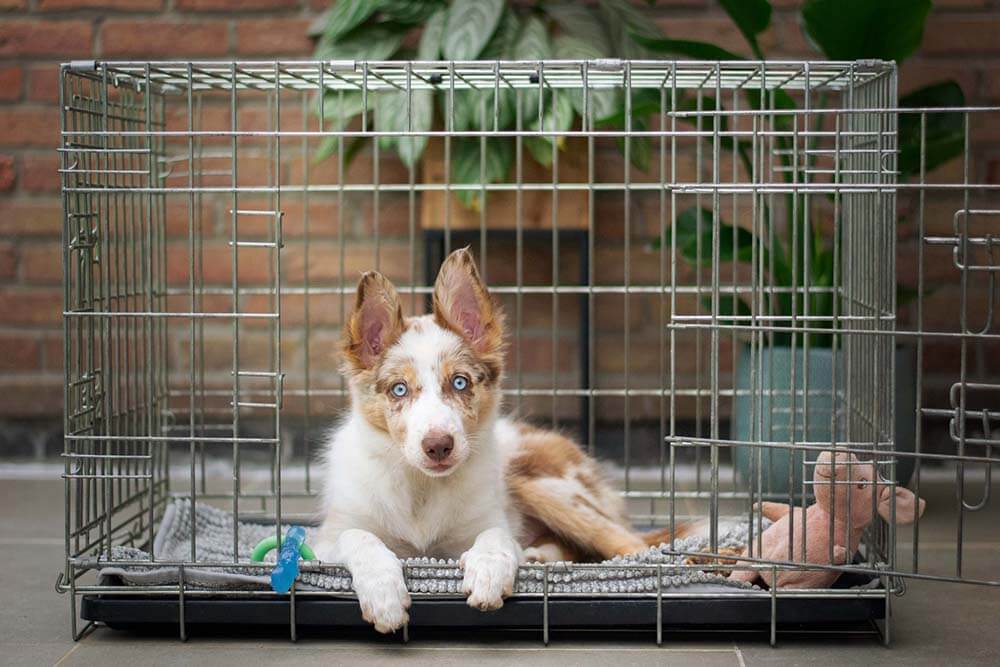
Cleaning up dog pee
The lingering scent of dog pee on your bed is a constant reminder to your dog to go there for potty breaks, so clean up the mess as quickly and as thoroughly as possible.
Acting quickly will ensure the pee doesn’t soak too deeply into the mattress. Use a cleaning cloth to absorb as much of the pee as possible. Don’t wipe, as this will cause the stain to spread. Once you’re done cleaning, cover the spot with paper towels. Put soiled sheets in the washer.
You can spread baking soda over the area to soak up additional moisture. Vacuum this up after an hour. You can also rub dilute vinegar on the stain to reduce the dog pee odor.
It’s also likely your pet store sells products that can effectively mask the scent of canine urine.
In closing…
A dog peeing on the bed can be a true pain in the rear. Thankfully, understanding dog behavior and issues such as urinary tract infections, territorial marking, and canine anxiety can help you prevent your dog from having another accident at home.
Keep the above points in mind when bringing home a puppy or adult dog. This way, you can ensure the cleanliness of your bed, and your pet’s happiness and health!
